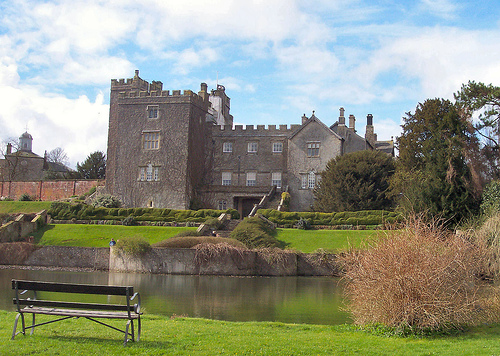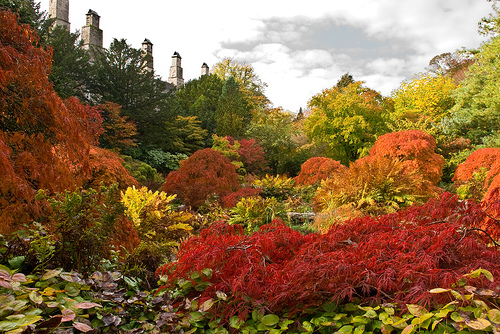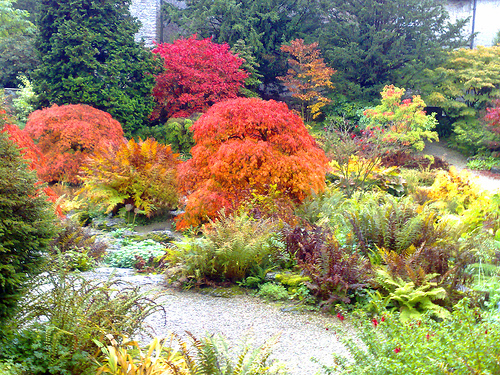

Location: Off A591 & A590, Sizergh, Cumbria Map
Tel. 015395 60951
Open: Apr- Oct: Sun- Th
Sizergh Castle is a medieval fortified house and estate located in Helsington, Cumbria, England, approximately 4 miles (6 km) south of Kendal and within the extended Lake District National Park since 2016. Situated at postcode LA8 8DZ, it overlooks the Lyth Valley and is surrounded by rolling countryside, with views toward the Kent Estuary and distant fells. The castle's name derives from the Old Norse "Siggarthr," meaning "clearing made by a scythe," reflecting its Viking-era roots in the region. Originally built as a pele tower for defense against border raids, it evolved into a stately home while retaining its rugged, stone-built character. Spanning a 647-hectare (1,600-acre) estate, Sizergh combines historic architecture, award-winning gardens, and diverse habitats, making it a prime attraction for history buffs, gardeners, and nature lovers. Managed by the National Trust since 1950, it remains the private residence of the Hornyold-Strickland family, offering a lived-in authenticity rare among heritage sites.
The estate's documented history begins in the 1170s with ownership by
the Deincourt family. In 1239, it passed to the Strickland family
through the marriage of Elizabeth Deincourt to Sir William de
Stirkeland, establishing a continuous lineage that lasted over 700 years
until the castle was gifted to the National Trust in 1950 by Lieutenant
Commander Thomas Hornyold-Strickland, 7th Count della Catena and
grandson of the 1st Baron Strickland. The Stricklands, a prominent
Catholic family, navigated turbulent times, including exile for Sir
Thomas Strickland with King James II and VII in the late 17th century. A
notable connection is to Katherine Parr, Henry VIII's sixth wife and a
Strickland relative, who likely resided at Sizergh after her first
husband's death in 1533; her second husband, Lord Latymer, was kin to
the dowager Lady Strickland.
The castle's defensive origins stem from
the 14th–15th centuries amid Anglo-Scottish border conflicts.
Elizabethan extensions in the late 16th century added grandeur, while
around 1770, the great hall was enlarged in Georgian style for comfort.
During the English Civil War, the Stricklands' Catholic sympathies led
to sequestration, but the property was restored post-1660. The 19th
century saw accessibility improvements, like Cecilia Strickland's ramp
built in the early 1800s for her mobility needs due to rheumatism. In
2014, a 35-hectare wetland was created in the Lyth Valley with Natural
England funding to boost biodiversity, part of the Morecambe Bay Nature
Improvement Area (2012–2015) and ongoing Morecambe Bay Partnership
efforts. Archaeological interest includes potential remains of a stone
circle on nearby Sizergh Fell, a 123-meter hill classified as a Tump.

Sizergh Castle is a Grade I listed building, its core a sturdy 14th-
or 15th-century pele tower of local limestone, designed for defense
with thick walls and narrow windows. This evolved into a U-shaped
fortified manor, blending military functionality with domestic
elegance through later additions. The Elizabethan era brought ornate
interiors, exemplified by the Inlaid Chamber—a rare survival of
16th-century oak paneling inlaid with floral and geometric patterns
in pale poplar and dark bog-oak. Its contents were sold to the
Victoria and Albert Museum in the 1890s and displayed as a period
room, but the paneling returned on long-term loan in 1999, with full
ownership transferring to the National Trust by 2017. Early
furnishings include three oak armchairs and three chests from the
mid-16th century, tied to Walter Strickland (1516–1569) and his wife
Alice Tempest.
Other highlights include the Drawing Room with a
large tapestry and a late-17th-century walnut-cased spinet by John
Player. The great hall, expanded Georgian-style around 1770,
features bargeboards on gables likely from the 17th century. The
house houses over 2,400 objects in the National Trust Collections,
including paintings and artifacts spanning centuries, showcasing
Elizabethan artistry and the family's Catholic heritage. Bargeboards
and gabled roofs add picturesque charm, while the overall design
harmonizes with the landscape, with 17th-century elements like the
semi-fortified layout emphasizing its border stronghold roots.

The gardens at Sizergh, registered Grade II on the Historic England
Register, have evolved over 800 years as a family creation, blending
formal design with wilder estate elements. Key features include the
expansive Rock Garden—the largest limestone rock garden in National
Trust ownership—constructed in the 1920s with winding paths amid
boulders and rare alpines. The Stumpery, a shaded fernery using
upturned tree stumps, evokes Victorian eccentricity, while the
Orchard hosts four national collections of hardy ferns, buzzing with
bees amid fruit trees. The Dutch Garden offers manicured topiary and
parterres, the Kitchen Garden supplies fresh produce with espaliered
fruits along heated walls, and the vibrant herbaceous border bursts
with perennials like salvias, echinaceas, and geraniums, peaking in
summer.
The Mirror Pond reflects the castle's silhouette,
especially striking in autumn with golden foliage from acers and
birches. Cecilia's Ramp, an early 19th-century stone incline built
for wheelchair access, was repurposed as a flowerbed after her 1814
death but is slated for reinstatement to highlight disability
history—contact sizergh@nationaltrust.org.uk for updates. The
estate's 647 hectares encompass diverse habitats: ancient parkland
enclosed by Edward III in 1336, wildflower meadows attracting
pearl-bordered and high-brown fritillary butterflies, hornbeam
groves drawing hawfinches, and the 2014 Lyth Valley wetland
fostering bitterns and waders. Woodland walks like the Purple and
Blue routes offer buggy-friendly paths, bird hides, and views of
beehives and free-range chickens, though some trails can be muddy.
As of September 22, 2025—a Monday—Sizergh Castle is fully open
during its main season (March 18 to November 2), with the house
accessible Tuesday–Sunday from 12:00 PM to 4:00 PM (last entry 3:15
PM), gardens and shop 10:00 AM to 5:00 PM, and café 10:00 AM to 5:00
PM. The car park operates year-round 9:00 AM to 7:00 PM. National
Trust members enter free; non-members pay £15–£18 for house and
garden combined (2-for-1 offers available via BBC Gardeners' World
Magazine at £10 in summer, £6 winter), with parking £3 (1 hour), £6
(2 hours), £7.50 (4 hours), or £9 all day for non-members. Winter
events, like the "Winter at Sizergh" light and sound trail (November
21–December 24), cost £4 for NT members and £14 for non-members.
Facilities include an on-site café with table service (praised for
hot meals), a well-stocked shop for plants, gifts, and books,
toilets with baby-changing, disabled access (wheelchairs available,
though some paths uneven), picnic areas, and dog-friendly woodland
walks (two-pawprint rating; leads required near livestock).
TripAdvisor rates it 4.3/5 from 1,669 reviews, with 2025 feedback
highlighting the "fascinating Strickland family film," "beautiful
rock gardens and acers," and family appeal (e.g., resident cat
interactions, children's trails). Positive notes include helpful
volunteers and the introductory video, while criticisms mention busy
periods, officious staff, past-prime summer blooms, and cash-only
parking machines. Allow 2–3 hours; it's ideal for combining with
Kendal visits or Lake District drives. Accessibility improvements
like the Holeslack Trail continue, and events such as Heritage Open
Days in September feature guided walks.